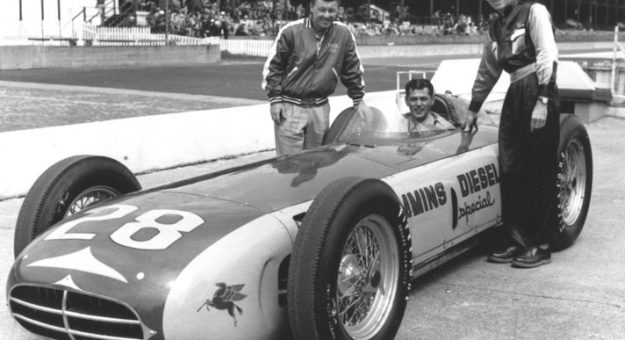Few in racing have enjoyed as a diverse involvement in the sport as Frederik Levon “Freddie” Agabashian. He competed in 11 Indianapolis 500s, won multiple midget championships and became a renowned radio and TV broadcaster.
The child of Armenian immigrants, Agabashian and his three sisters inherited a compulsive desire to succeed. His sisters became singers of note. Alice in particular gained fame with her radio programs in San Francisco and a long career as a Reno lounge singer.
Freddie chose racing.
In 1930, at only 17, the high school senior began racing a Chevy track roadster at tracks near his Modesto, Calif., home.
He won that year’s Northern California Roadster Championship, despite a grinding accident at San Jose where he lost 17 teeth, fractured his jaw and suffered internal injuries.
Surviving the dramatic crash spurred Agabashian’s next career move. He spent three years with Irish Horan’s Auto Daredevils stunt show.
During this time, Agabashian also began dabbling in midget racing and gradually expanded his involvement in the fast-growing sport. He earned the 1937 Northern California Racing Ass’n title and was a regular feature winner until World War II shuttered auto racing.
After the hostilities, his career skyrocketed. Driving for Jack London, he captured the prestigious Bay Cities Racing Ass’n crown in 1946, winning 36 features. He then switched to up-and-coming car owner/mechanic George Bignotti’s car and captured the BCRA championship again in 1947 and ’48.
Agabashian’s peppery personality combined with his eye-catching uniforms created by his wife, Mabel, made him one of the more conspicuous competitors of his day and one of the first to capitalize on public relations.
His name was soon being bandied about by Indianapolis car owners, and he made his first appearance there in 1947. Driving Ross Page’s Kurtis, powered by an odd supercharged Duray engine, the rookie raced from 23rd to finish ninth.
Ten consecutive 500 appearances followed and despite falling short of a victory, fourth in 1953 was his best placement, Agabashian was annually ranked among the favorites. He displayed his mastery of the speedway with three consecutive front-row starts. The most acclaimed of these was his historic 1952 pole run that established his legacy.
In late 1951, representatives of the Cummins Engine Co. in Columbus, Ind., approached Agabashian about driving the radical car they were developing for the 1952 500. Cummins invested in excess of $150,000 ($1.6 million today) in the car intended to test and publicize the company’s latest diesel truck engine.
Utilizing the first turbocharger in racing history, the 400-cubic-inch diesel pumped out more than 430 horsepower. Cummins turned to Frank Kurtis to build a chassis. It was as radical as the engine. Housing the engine only five degrees from horizontal created an extremely low profile. Contributing to the minimal profile, it stood only two feet at the cowling. The driveshaft, similar to that year’s Vukovich roadster, ran alongside the driver.
The drawback was that because of the massive, high-powered engine the car’s components required considerable beefing, resulting in it weighing nearly twice as much as conventional cars.
It possessed potential for speed as Agabashian discovered during practice. Sandbagging, he never turned a complete lap at speed. Consequently, on Pole Day he astonished the crowd with the first lap in excess of 139 mph and the first four-lap average better than 138 mph. The pole was his.
But there were problems. Because of the car’s excessive weight, the tires shredded in only four qualifying laps. That didn’t bode well for the race.
Agabashian fell back at the green flag and never led a lap. After 71 laps the team retired the car, explaining the nose-mounted turbocharger air inlet had clogged from debris. Cummins enjoyed an enormous amount of publicity and never raced the car again.
Agabashian competed in seven additional 500s before retiring in 1958.
A leading spokesman for the Champion Spark Plug Highway Safety Team, he spoke to schools and civic organizations across the nation. Millions came to know him from his stints as the driver analyst on the speedway’s radio broadcast of the 500.
He returned to the speedway until his death on Oct. 13, 1989, acting as a respected mentor to young drivers.
